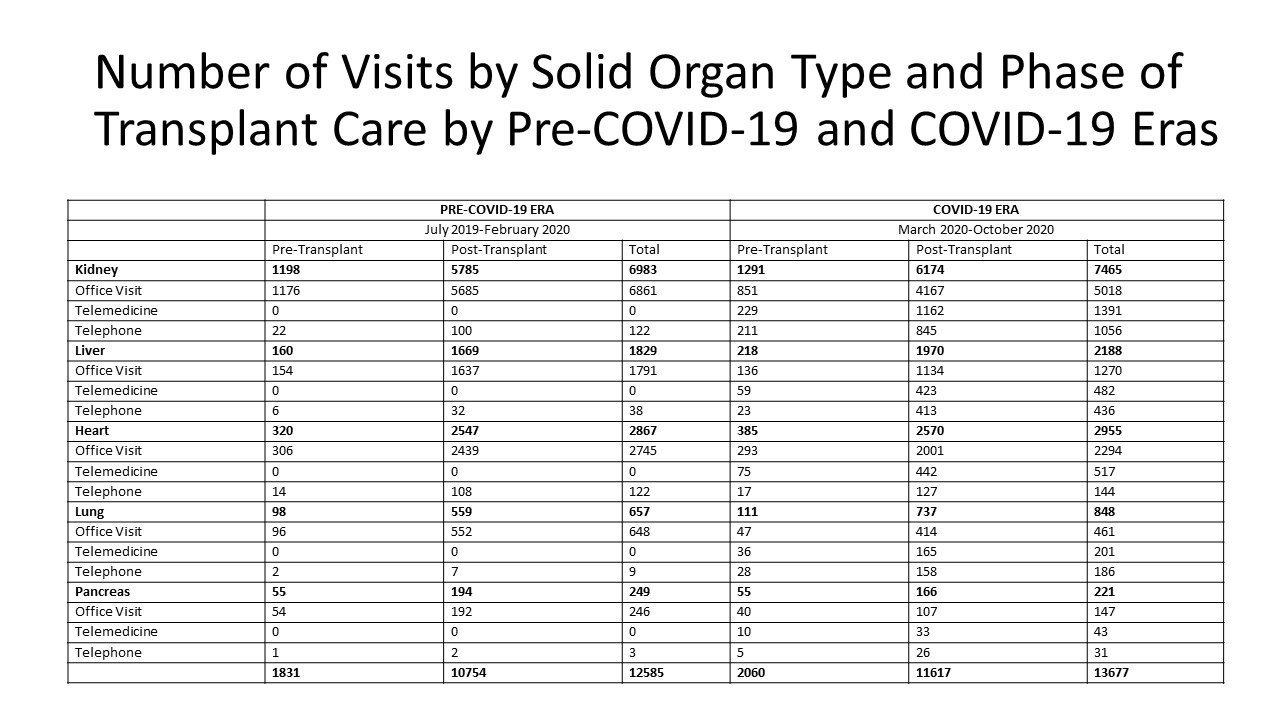Solid Organ Transplant Telehealth Utilization Significantly Increased During the Covid-19 Pandemic: Experience at a Single, Large Volume Center
Vanderbilt University Medical Center, Nashville, TN
Meeting: 2021 American Transplant Congress
Abstract number: 1262
Keywords: Economics, Monitoring, Outpatients
Topic: Clinical Science » Organ Inclusive » Non-Organ Specific: Disparities to Outcome and Access to Healthcare
Session Information
Session Name: Non-Organ Specific: Disparities to Outcome and Access to Healthcare
Session Type: Poster Abstract
Session Date & Time: None. Available on demand.
Location: Virtual
*Purpose: During the COVID-19 pandemic, telehealth utilization has allowed for the delivery of healthcare while protecting patients, caregivers, healthcare workers, and the community from exposure. We examined the effect of the COVID-19 pandemic on utilization of telehealth in the care of all solid organ transplant patients in all phases of transplant care at our center.
*Methods: All patients seen at Vanderbilt University Medical Center for solid organ transplant during any phase of care (referral, evaluation, waitlist, or post-transplantation) from July 1, 2019 through October 31, 2020 were included in this retrospective analysis. Patients seen from July 1, 2019 through February 29, 2020 were identified as a Pre-COVID-19 era cohort. Patients seen from March 1, 2020 through October 31, 2020 were the COVID-19 era cohort. Pretransplant phases of care included referral, evaluation and waitlist; those transplanted were considered posttransplant. Telehealth visits included telemedicine, defined as those conducted by face-to-face (F2F) videoconferencing, and telephone.
*Results: Total visit number for all solid organs (kidney, liver, heart, lung, and pancreas) were similar between eras (12585 vs. 13677) [Figure]. There was a significant increase in the use of telehealth in the COVID-19 era for all organ types with the pre-era ranging from 1.2-4.3% while post ranged from 22.4-45.6% [Table]. Telemedicine was not used during the pre-COVID-19 era and its use increased to 17.5-23.7% of all visits by organ type during the COVID-era.
*Conclusions: The COVID-19 pandemic has accelerated the use of telehealth in all phases and types of solid organ transplantation. The use of telemedicine although increased represents a minority of total visits and the increased use of telephone visits suggest barriers may remain to more widespread adoption of F2F technology that warrant further investigation.
| Pre- | COVID-19 | Era | COVID-19 | Era | ||
| Telemedicine | Telephone | Telehealth | Telemedicine | Telephone | Telehealth | |
| Kidney | 0 | 1.7 | 1.7 | 18.6 | 14.2 | 32.8 |
| Liver | 0 | 2.1 | 2.1 | 22 | 20 | 42 |
| Heart | 0 | 4.3 | 4.3 | 17.5 | 4.9 | 22.4 |
| Lung | 0 | 1.4 | 1.4 | 23.7 | 21.9 | 45.6 |
| Pancreas | 0 | 1.2 | 1.2 | 19.5 | 14 | 33.5 |
To cite this abstract in AMA style:
Forbes R, Kumm K, O'Dell H, Smith K, Smith L, Dreher A, Schaefer H, Concepcion B. Solid Organ Transplant Telehealth Utilization Significantly Increased During the Covid-19 Pandemic: Experience at a Single, Large Volume Center [abstract]. Am J Transplant. 2021; 21 (suppl 3). https://atcmeetingabstracts.com/abstract/solid-organ-transplant-telehealth-utilization-significantly-increased-during-the-covid-19-pandemic-experience-at-a-single-large-volume-center/. Accessed December 24, 2025.« Back to 2021 American Transplant Congress

